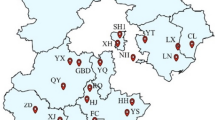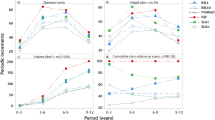Abstract
To determine appropriate quantities of water and fertilizer required for early growth of hybrid poplar cuttings, we recorded the growth traits of four clones grown under four factors (irrigation and nitrogen, phosphorus, and potassium fertilizers), each with four levels, using an orthogonal experimental design. A logistic model was used to estimate growth in height. The growth curves for tree height were sigmoid, and the model R2 values were greater than 0.9, which indicated that the fit was highly significant. ANOVA results for tree height and basal diameter indicated that all sources of variance showed significant differences (p < 0.001). The average tree height and basal diameter for all the four clones under the different treatments ranged from 155.39 to 235.04 cm, and from 13.71 to 17.42 mm, respectively. A highly positive correlation between the extreme k value and tree height was observed, suggesting that the k value was an accurate estimation of tree height. For model parameters, the earliest average time point for the onset of the rapid growth period of poplar clones was 131 d, and the highest average increment in tree height during the rapid growth period was 138.78 cm. The highest average tree height for all clones under each factor was 219, 210.51, 200, and 201 cm when treated with either 1200 mL of water applied every third day, 3 g of nitrogen, 0 g of phosphorus, or 0 g of potassium, respectively. The most suitable treatment for the early growth of hybrid poplar cuttings, as suggested by the developed logistic model, was 1200 mL of water applied every third day and three applications of 1 g nitrogen (in the form of CH4N2O).



Similar content being viewed by others
References
Avanza M, Bramardi S, Mazza S (2008) Statistical models to describe the fruit growth pattern in sweet orange ‘Valencia late’. Span J Agric Res 6(4):577–585
Cooke JE, Marttin TA, Davis JM (2005) Short term physiological and developmental responses to nitrogen availability in hybrid poplar. New Phytol 167(1):41–52
Dong WY, Qin J, Li JY, Zhao Y, Nie LS, Zhang ZY (2011) Interactions between soil water content and fertilizer on growth characteristics and biomass yield of Chinese white poplar (Populus tomentosa Carr.) seedlings. Soil Sci Plant Nutr 57(2):303–312
Elferjani R, Des RA, Tremblay F (2013) DRIS-based fertilization efficiency of young hybrid poplar plantations in the boreal region of Canada. New For 44(4):487–508
Fourcaud T, Zhang X, Stokes A, Lambers H, Körner C (2008) Plant growth modelling and applications the increasing importance of plant architecture in growth models. Ann Bot 101(8):1053–1063
Guillemette T, Des RA (2008) Early growth and nutrition of hybrid poplars fertilized at planting in the boreal forest of western Quebec. For Ecol Manag 255(7):2981–2989
Hansen J, Roulund H (1997) Genetic parameters for spiral grain, stem form, pilodyn and growth in 13 years old clones of Sitka Spruce (Picea sitchensis (Bong.) Carr.). Silvae Genetica 46:107–113
Hart QJ, Tittmann PW, Bandaru V, Jenkins BM (2015) Modeling poplar growth as a short rotation woody crop for biofuels in the Pacific Northwest. Biomass Bioenerg 79:12–27
Herault B, Bachelot B, Poorter L, Rossi V, Bongers F, Chave JM (2011) Functional traits shape ontogenetic growth trajectories of rain forest tree species. J Ecol 99(6):1431–1440
Isebrands J, Rosemeier D, Wyatt G, Zamora D, Brainerd MM (2007) Best management practices poplar manual for agroforestry applications in Minnesota. USDA, Washington, pp 28–29
Lasa B, Jauregui I, Aranjuelo I, Sakalauskiene S, Aparicio PM (2016) Influence of stage of development in the efficiency of nitrogen fertilization on poplar. J Plant Nutr 39(1):87–98
Liu M, Bian X, Ma WJ, Shao LT, Yao LX, Meng BN, Liu GF, Zhao XY (2014) Logistic model Building of seedling growth traits in Transgene Populus simonii × P. nigra clones carrying TaLEA gene. Bull Bot Res 34(4):485–491
Martins FB, Soares CP, Silva GF (2014) Individual tree growth models for Eucalyptus in northern Brazil. Scientia Agricola 71(3):212–225
Pitre FE, Cooke JE, Mackay JJ (2007) Short-term effects of nitrogen availability on wood formation and fibre properties in hybrid poplar. Trees 21(2):249–259
Pliura A, Zhang SY, Mackay J, Bousquet J (2007) Genotypic variation in wood density and growth traits of poplar hybrids at four clonal trials. For Ecol Manag 238:92–106
Sharma RP, Vacek Z, Vacek S, Jansa V, Kucera M (2017) Modelling individual tree diameter growth for Norway spruce in the Czech Republic using a generalized algebraic difference approach. For Sci 63:227–238
Singh B, Sharma K (2007) Tree growth and nutrient status of soil in a poplar (Populus deltoides Bartr.)-based agroforestry system in Punjab, India. Agrofor Syst 70(2):125–134
Toillon J, Fichot R, Dallé E, Berthelot A, Brignolas F, Marron N (2013) Planting density affects growth and water-use efficiency depending on site in Populus deltoides × P. nigra. For Ecol Manag 304:345–354
Van DR, Thomas BR, Kamelchuk DP (2008) Effects of N, NP, and NPKS fertilizers applied to four-year old hybrid poplar plantations. New Forest 35(3):221–233
Wang Y, Xi BY, Bloomberg M, Moltchanova E, Li GD, Jia LM (2015) Response of diameter growth, biomass allocation and N uptake to N fertigation in a triploid Populus tomentosa plantation in the north China plain: ontogenetic shift does not exclude plasticity. Eur J For Res 134(5):889–898
Wang Y, Liu Y, Li GL, Hu JW, Lou JS, Wan FF (2016a) Effect of container types and sizes on water consumption and growth of containerized Pinus tabulaeformis seedling under sub-irrigation. Scientia Silvae Sinicae 52:10–17
Wang ZG, Su YP, Zhang Y, Guo HS, Meng DF, Wang Y (2016b) Ecology-types determine physicochemical properties and microbial communities of sediments obtained along the Songhua River. Biochem Syst Ecol 66:312–318
Yang B (2006) Studies on annual growth model of willow at seeding stage. J N For Univ 21:97–99
Zabek LM, Prescott CE (2007) Steady-state nutrition of hybrid poplar grown from un-rooted cuttings. New For 34(1):13–23
Zhang YM, Gai JY (1994) The parameters estimation of logistic model. J Sichuan Inst Anim Husb Vet 8:47–52
Zhao Y (2010) Studies on effects of fertilization on hybrid clone seedlings of Populus tomentosa. Doctor Dissertation of Beijing Forestry University. Beijing Forestry University, Beijing
Zhao XY, Zhang ZY (2013) Model construction of seedling growth for hybrid clones of Populus tomentosa. J Beijing For University 35(5):15–21
Zhao XY, Bian XY, Liu MR, Li ZX, Li Y, Zheng M, Teng WH, Jiang J, Liu GF (2014) Analysis of genetic effects on a complete diallel cross test of Betula platyphylla. Euphytica 200:221–229
Zhou YM, Xie ZS, Liu SQ, Liu XT (2004) The application of logistic model on growth process estimation of Eucalyptus. J Nanjing For Univ 28(6):107–110
Author information
Authors and Affiliations
Corresponding author
Additional information
Publisher's Note
Springer Nature remains neutral with regard to jurisdictional claims in published maps and institutional affiliations.
Project funding: This work was financially supported by the National Key Research and Development Program of China (Grant No. 2016YFD0600404) and the Fundamental Research Funds for the Central Universities (2572017DA02).
The online version is available at http://www.springerlink.com.
Corresponding editor: Tao Xu.
Rights and permissions
About this article
Cite this article
Ahmed, A.K.M., Jiang, L., Wang, F. et al. Variation analysis of growth traits of four poplar clones under different water and fertilizer management. J. For. Res. 31, 45–55 (2020). https://doi.org/10.1007/s11676-019-00888-y
Received:
Accepted:
Published:
Issue Date:
DOI: https://doi.org/10.1007/s11676-019-00888-y




